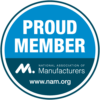Whether the pandemic, supply chain issues, gas prices, cyber breaches, or the looming recession, every manufacturer needs to have a plan in place for managing through a crisis. A crisis could be in the form of a short term issue or some crises can take years to recover from, if you recover at all. Below you will find a few examples of crisis situations and how to put together a plan.
Equipment Maintenance
Keeping your equipment in peak condition in a manufacturing facility is vital. In many plants, if even one piece of equipment goes down, the whole operation could shut down. Equipment maintenance must be a HIGH priority in any Manufacturing plant and, if not done on a regular schedule, your equipment could shut down the whole process. There are times when regularly scheduled maintenance needs to happen, even if this may temporarily disrupt production.
To prevent an unplanned shut down from happening, every piece of equipment you have in your plant that is vital to the production of your product needs to be on a routine maintenance schedule. On a regular basis, your Maintenance Manager and Manufacturing Manager/Supervisor need to coordinate the best time to maintain the equipment. Outdated machinery should be replaced or modernized. As part of your Crisis Plan, it is vital to create and keep a schedule log to track the work that needs to be performed, what was completed, and when.
Human Error
Your biggest opponent in life is yourself. Messing around, disregarding safety protocols, and being exhausted while on the job can result in both personal injury and potential lines being shut down due to product and/or equipment damage. Have you, as a Manager/Supervisor, ever expedited a new employee out onto the floor because you were busy and needed the extra hands and due to time constraints, skipped imperative training topics? Have new training documents come out onto the floor for your department for critical equipment and you thought it could wait a couple of days to be completed? Just by forgoing any training document by even one day, you as a Manager/Supervisor, could cause your employee and/or yourself personal injury and/or damage to your equipment.
Your business is only as strong as your weakest link and you don’t want your weakest link to be your employees. Make sure you have a safety officer/team in place, and that they are up to date on all the latest training and safety protocols that pertain to your company policies. They need to hold regular safety meetings and walk-through inspections. Educating and training your employees on a regular basis, for their specific job roles, is vital in reducing the overall likelihood of human error.
Supply Chain Issues
Your supply chain is critical for your operations. If you are dependent on your vendors to provide material at a specific time and they don’t meet your demand, this can put a wrench in your production requirements and schedule. Suppose you just signed two of the largest contracts your company has ever seen. You have three suppliers you buy from, but one of them is not very reliable and one of the other two will be shut down for the upcoming holiday. You have already committed to a short time period for both new jobs. Do you have a back-up supplier for “a just in case” scenario?
Always make sure you have more than one supply vendor in a Crisis Plan. Multiple vendors will give you more options and security in knowing that you have alternatives to fall back on when time is critical. You need to develop a reasonable approach to handling any supply disruptions. Identify and document your supply chain risks and make them visible to your company’s management team on a regular basis. These risks should be evaluated for each project and assessed for severity and probability. Monitoring your internal and external supply chain risks will allow your company to evaluate any potential impacts and mitigate any potential negative changes.
Ambiguous Work Instructions
The consequence of ambiguous work instructions can result in defective or poor quality in your final product. If your facility does not follow proper work instructions on the production floor, chances are that you are experiencing issues due to lack of training, human error, downtime on the production floor, and a lot of missed shipping dates on your jobs. You have now wasted time, produced an inferior product, reduced productivity, and frustrated your staff. With a higher incidence of poorly finished product coming off the line, reworking the product will incur additional labor costs, lowering your profit margin. Any undetected failures that make it out the door have a potential negative impact on customers, your brand name, and your reputation.
Your work instructions need to be drafted by the production department, not by someone from another department that cannot identify the steps or parts that are required to build an item. This avoids all the guesswork and misconceptions and provides the rough draft of the work instruction. When writing the instructions, don’t use too many long sentences or excessive technical “mumbo-jumbo”. You want to be able to explain it in simple terms and well enough so that anybody can understand it. Take photos of every step and use these in your work instructions to clearly illustrate the various processes.
Natural Disasters
Depending on where you are located, you may face an earthquake, hurricane, tornados, fires, floods, or massive snowstorms. Each one of these will cause widespread destruction and can impact local economies for weeks or months to come. These natural disasters and many others like them can cause damage beyond belief.
Most companies don’t have a Crisis Plan in place for situations like this. You can’t predict the weather. For some of the predictable natural disasters that you get warnings about, you can conduct awareness training within the facility on evacuation routes and procedures as needed, depending on the area. You can coordinate with local and state response agencies about the community evacuation routes. Be prepared by having emergency supplies on hand. Monitor the radio and/or television reports and have a plan on how to secure your facility, remembering to secure and back up the critical electronic files for the company.
In summary, having a Crisis Plan for any situation is your best option. While these are just a few of the examples of what can cause a crisis within your Production facility at any moment, establishing a Crisis Plan in advance can help you get through it efficiently. Take a walk through your facility, identify potential problems, create a list of ways to prevent or mitigate the problem and make a plan.



